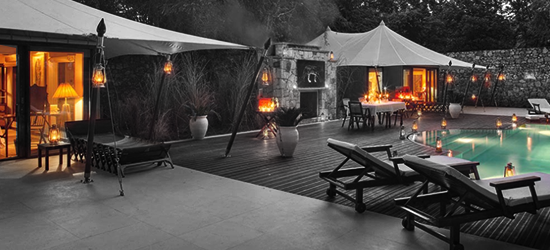
Welcome
Atithi
Sublime Jodhpur
Travel Ideas
Go Beyond Luxury, Feel the Opulence

Welcome
Go Beyond Luxury, Feel the Opulence
Deep in the heart of Rajasthan, you will find Jodhpur, a fascinating city to explore. Jodhpur is the former capital of the Marwar state, which was founded in 1459 by Rao Jodha, a Rajput chief of the Rathore clan. It is currently the 2nd largest city in the state of Rajasthan and it echoes with tales of antiquity in the vastness of the nearby Thar Desert. Jodhpur is popularly known as the "Blue City" among the people of Rajasthan due to the wide array of blue houses located in the historic districts of the city. In centuries past, Jodhpur was located on the strategic road linking Delhi to Gujarat. This enabled it to profit from a flourishing trade in copper, silk, sandalwood, dates, and other goods. The old city surrounds the centrally located Mehrangarh Fort and is bounded by a wall with several gates.

The last of the great palaces of India, the property houses a family museum, as well as the resplendent Umaid Bhawan Palace. Set amidst 26 acres of lush gardens, with dancing peacocks and a subterranean Zodiac Pool, the luxury five-star Taj heritage hotel offers 64 utterly breathtaking Art Deco- style rooms and suites.
Tantalise your taste buds at Risala with authentic Rajasthani and Indian cuisine. Discover an array of European and Mediterranean delicacies at Pillars, set in a lovely colonnaded veranda. Unwind at the Trophy Bar with its unique hunting-themed décor and vast selection of alcoholic beverages and cigars.

RAAS JODHPUR – a Luxury Boutique Hotel, set under the imposing stare of Mehrangarh Fort, situated in the prestigious North-Easter quarter of the Walled City and a stone’s throw from the Clock Tower. The hotel is built around an immaculately restored haveli, which houses the Heritage Suites, spa, boutiques and excellent Baradari and Darikhana Restaurant, serving both Indian and International food. Other rooms are in three modern buildings, built using traditional techniques and local materials, and overlooking the Mehrangarh Fort.

The Vivanta by Taj - Hari Mahal is spread over 6 acres of lush, landscaped gardens and located close to the city centre. Spread over 6 acres of landscaped gardens, the luxurious Taj Hari Mahal is built to resemble a 14th century royal palace, presenting Moghul-inspired domes and grand architecture.

When the entire world was fascinated about the grandeur and magnificence of royal Rajasthan and the kingly lifestyle of its Maharajas and Maharanis, the Rajput scions of Jodhpur introduced the first Heritage Hotel of India named Ajit Bhawan. Plunge into an experience exclusively meant for the royal connoisseurs. An imposing blend of crisp luxuries and impressive heritage, Ajit Bhawan stands as an epitome of self- indulgent and upscale hospitality in Jodhpur.

Luxury tents have always played an important part in Rajput lifestyle. Constant safari campaigns in far-flung lands meant long stays in tents in inhospitable conditions. These tents were the only luxury available and soon these ‘homes away from home’ evolved into mobile, mini-palaces. RAAS Chhatrasagar captures this romance. The new tents are larger, sound-proofed and more solid structures. Each is contemporary with soft muted colours, Jodhpur stone, teak furniture and sky lights; understated but chic and fresh. Every space has air-conditioning and heating so the camp remains open all year round – one of the few tented camps in India to do so.

Mihir Garh is an exclusive nine suite boutique hotel where each room offers you more than 1700 sq. of pure luxury. The private terraces, courtyards, plunge pools and Jacuzzi seem to whisper a single word: Indulge. Here, serenity and splendour come together to create an experience for you. While exotic drinks from your personal mini-bar become the manna for a sultry summer afternoon, the fireplace morphs into an intimate friend for wintry nights. You can pamper yourself with the variety of treatments available at Mihir Garh's spa or rejuvenate at the poolside while watching the endless desert meditate with the horizon. The delectable cuisines too aim to please - from traditional to continental - to suit your palate

The peace and tranquillity of the environs have drawn writers from around the world. Rohet Garh has had the honour and privilege of hosting some of the most respected names in the literary world. Bruce Chatwin and William Dalrymple practically lived at Rohet Garh for four to five months working on their respective books, The Song-lines and The City of Djinns.

Amongst spellbinding, billion-year-old granite rock formations, where leopards roam wild and free, coexisting comfortably with the charismatic communities, is the pioneering SUJÁN JAWAI. Spectacularly set in a dramatic wilderness, the camp celebrates the great outdoors with panache. Spend unforgettable days in the wilderness tracking leopards and other wildlife. Blending sophistication and ecology, there is no better place to discover one of India’s most enchanting and breathtakingly beautiful landscapes.
With Just ten tented suites now new "Eden at jawai", the Royal 'Panthera' suite and Family 'Felidae' Suite, Sujan Jawai redefines responsible luxury in the wilderness.
The Mehrangarh Fort is a massive citadel spread over 1200 acres and located on a steep hill overlooking the city below. The fort appears rugged and impenetrable from the outside but houses some of the most intricately adorned palaces with exquisitely carved panels and latticed windows. Moti Mahal, Phool Mahal and Sheesh Mahal are some of the palaces within the walls that are worth exploring. The fort was constructed 1459-60 CE by Rajput ruler Rao Jodha, though most of the existing structure is from the 17th century. Unbeatable and impressive, the epic grandeur of this red sandstone wrapped fortress is enhanced by its eccentric beauty. The colossal structure also boasts of a museum that displays fascinating and precious artworks of great historical value.
Jaswant Thada is a cluster of royal cenotaphs formed from white marble and built in 1899 CE as a memorial to Maharaja Jaswant Singh II. This stunning white monument is perched atop a hill high above the Blue City below, allowing sweeping views of the surrounding area. The mausoleum is built out of intricately carved and extremely thin sheets of marble, which are highly polished such that they emit a warm glow when illuminated by the sun. The cenotaph's grounds feature carved gazebos, a tiered garden, and a small lake. There are three other cenotaphs in the grounds and the cenotaph of Maharaja Jaswant Singh displays portraits of the rulers and Maharajas of Jodhpur. While strolling the sacred grounds, you will feel tranquility and peace from the stately monuments to the former rulers.
Umaid Bhavan Palace is one of the world’s largest residences which has now been converted into a high-end luxury hotel. Also open for tours of the museum located inside, the palace is one of the most visited places in Jodhpur when it comes to witnessing the luxurious side of the city. Step into the opulent rooms of the palace and enjoy a celebrated destination when it comes to the famous places in Jodhpur. This palace is named after Maharaja Umaid Singh, grandfather of the current owner Gaj Singh. Crowned with several features that make it an exquisite structure, the palace has 347 rooms and a part of it is operated by the Taj Group of Hotels. You can stroll its galleries housing various regal items, including rooms containing a host of royal clocks and one displaying exquisite vintage cars.
Take an exciting stroll through the Sagar Market in the center of town to discover the many sights and sounds of daily life. Long rows of stalls full of produce and various crafts fill the busy marketplace, its aisles bustling with shoppers. Ghanta Ghar, popularly known as the central Clock Tower, is one of the most iconic places to visit in Jodhpur. Located next to Sardar Market, Ghanta Ghar was built by Maharaja Sardar Singh when he reigned in the area during the early 1900s.
Mandore Gardens is one of the most beautiful places to visit in Jodhpur city. Brimming with cenotaphs, old temples, and several other sights, including the Hall of Heroes, which is dedicated to Rajput folk heroes and several deities. The Shrine of the Three Hundred Million Gods is another attraction of this garden. Over the centuries, the Mandore area served as the capital of many Jodhpur kings, and even witnessed several invasions from different dynasties, including the Muslim rulers of Gujarat and Malwa. In order to protect Mandore further from invasions, the capital was shifted to the hilltop Mehrangarh Fort, as it offered better safety and protection to the royal kingdom.
Another popular curiosity in Jodhpur is the step well known as Toorji ka jhalra. The concept of a step well in India is extremely significant, as it played a key role in survival in the arid deserts of India. The sand was dug dozens of meters deep to find water, and the surrounding walls of the great well were lined with ornately carved stones. Although it seems like a simple source of water, the step well shows off an amazing artistry in the many stone walls.
Take in a full-day Rural Safari of local Bishnoi villages to explore the local culture, food and arts & crafts of the region. Bishnoi is a tribal social group found in the Western Thar Desert of India. The lifestyle is simple and very much in harmony with the natural surroundings. They are vegetarians, follow the principles of non-violence and reverently protect all flora & fauna. You will also have the chance to view the creation of arts and crafts which are local to the area or are made for export to the larger cities for sale. Take this opportunity to view the local residents carrying out daily tasks of this rural lifestyle.
Travel a wider loop on your day trip and stop at Marwar, where you will learn about the Jooti (Jutti) leather manufacturing process as well as other handicrafts. The Jutti is a type of footwear common in North India and neighboring regions. They are traditionally made up of leather and decorated with extensive embroidery in real gold and silver thread as inspired by Indian royalty over 400 years ago. Juttis have evolved into several localized design variations, even depending upon the shoemaker. Despite the changing times, juttis have remained part of ceremonial attire, especially at weddings. The unembellished juttis are worn for everyday use for both men and women.